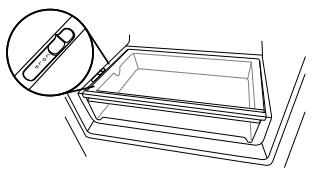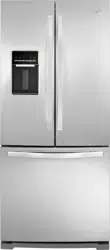Documents: Go to download!
- Owner's manual - (English, French, Spanish)
- INSTALLATION INSTRUCTIONS
- FILTERS AND ACCESSORIES
- REFRIGERATOR USE
- REFRIGERATOR FEATURES
- DOOR FEATURES
- TROUBLESHOOTING
Table of contents
Use Manual Refrigerator
INSTALLATION INSTRUCTIONS
Unpack the Refrigerator
WARNING: Excessive Weight Hazard
Use two or more people to move and install refrigerator.
Failure to do so can result in back or other injury.
Remove the Packaging
- Remove tape and glue residue from surfaces before turning on the refrigerator. Rub a small amount of liquid dish soap over the adhesive with your fingers. Wipe with warm water and dry.
- Do not use sharp instruments, rubbing alcohol, flammable fluids, or abrasive cleaners to remove tape or glue. These products can damage the surface of your refrigerator. For more information, see “Refrigerator Safety.”
- Dispose of/recycle all packaging materials.
When Moving Your Refrigerator:
Your refrigerator is heavy. When moving the refrigerator for cleaning or service, be sure to cover the floor with cardboard or hardboard to avoid floor damage. Always pull the refrigerator straight out when moving it. Do not wiggle or “walk” the refrigerator when trying to move it, as floor damage could occur.
Clean Before Using:
After you remove all of the packaging materials, clean the inside of your refrigerator before using it. See the cleaning instructions in “Refrigerator Care.”
Important information to know about glass shelves and covers:
Do not clean glass shelves or covers with warm water when they are cold. Shelves and covers may break if exposed to sudden temperature changes or impact, such as bumping. Tempered glass is designed to shatter into many small, pebble-size pieces. This is normal. Glass shelves and covers are heavy. Use both hands when removing them to avoid dropping.
Location Requirements
 WARNING: Explosion Hazard
WARNING: Explosion Hazard
Keep flammable materials and vapors, such as gasoline, away from refrigerator.
Failure to do so can result in death, explosion, or fire.
To ensure proper ventilation for your refrigerator, allow for a ¹⁄₂" (1.25 cm) of space on each side and at the top. Allow for a 1" (2.54 cm) space behind the refrigerator. If your refrigerator has an ice maker, allow extra space at the back for the water line connections. When installing your refrigerator next to a fixed wall, leave a 2" (5.08 cm) minimum space between the refrigerator and wall to allow the door to swing open.
NOTE: This refrigerator is intended for use in a location where the temperature ranges from a minimum of 55°F (13°C) to a maximum of 110°F (43°C). The preferred room temperature range for optimum performance, which reduces electricity usage and provides superior cooling, is between 60°F (15°C) and 90°F (32°C). It is recommended that you do not install the refrigerator near a heat source, such as an oven or radiator.
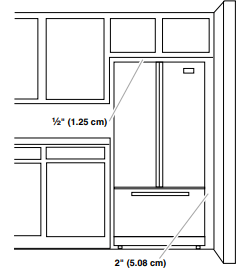
Remove and Replace Refrigerator
 WARNING: Electrical Shock Hazard
WARNING: Electrical Shock Hazard
Disconnect power before removing doors.
Failure to do so can result in death or electrical shock.
Doors and Drawer Front
Depending on the width of your door opening, it may be necessary to remove the refrigerator doors to move the refrigerator into your home.
Remove Doors and Hinges
IMPORTANT:
- If the refrigerator was previously installed and you are moving it out of the home, before you begin, turn the refrigerator control OFF, and unplug the refrigerator or disconnect power. Remove food and any adjustable door or utility bins from doors.
- Keep the refrigerator doors closed until you are ready to lift them free from the cabinet. Provide additional support for the refrigerator door while the hinges are being removed. Do not depend on the door gasket magnets to hold the door in place while you are working.
- All graphics referenced in the following instructions are included later in this section after “Final Steps.”
TOOLS NEEDED: ⁵⁄₁₆", ³⁄₈", and ¹⁄₄" hex head socket wrenches, Torx®† T25 screwdriver, #2 Phillips screwdriver, and a flat-blade screwdriver.
Remove Doors and Hinges
- Unplug refrigerator or disconnect power.
- Remove the base grille. Grasp the grille firmly and pull it toward you.
- Starting with the right-hand side door, remove the parts for the top hinge as shown in Top Hinge graphic. Lift the refrigerator door from the bottom hinge pin.
- Remove the hinge pin cover from the bottom hinge pin and keep it for later use. See Bottom Hinge graphic.
- Remove top hinge cover from the left-hand side refrigerator door. Remove the parts for the top hinge as shown in Top Hinge graphic.
External Dispenser Models Only:
■ Disconnect the wiring plug, located under the top left-hand side door hinge, by wedging a flat-blade screwdriver or your fingernail between the two sections. See Wiring Plug graphic.
■ Disconnect the water line, located under the top left-hand side door hinge, by pulling back on the locking collar while pulling the water line out of the water line connector. See Water Dispenser Tubing Connection graphic.
6. Lift the left-hand side door from the bottom hinge pin.
NOTE: On some models, remove the hinge pin cover from the bottom hinge pin and keep it for later use. See Bottom Hinge graphic.
Replace Doors and Hinges
1. Replace the parts for the bottom hinge as shown in Bottom Hinge graphic. Tighten screws. Replace the refrigerator door.
NOTE: Provide additional support for the refrigerator door while the hinges are being moved. Do not depend on the door gasket magnets to hold the door in place while you are working.
2. Assemble the parts for the top hinges as shown in Top Hinge graphic. Do not tighten the screws completely.
External Dispenser Models Only:
- Reconnect the wiring plug on top of the left-hand side refrigerator door.
- Reconnect the water line by pulling back the locking collar ring while firmly pushing the water line into the connector. Check for leaks.
3. Align the door so that the bottom of the refrigerator door aligns evenly with the top of the freezer drawer. Tighten all screws.
4. Replace the top hinge covers.
Remove and Replace Freezer Drawer Front
IMPORTANT: Two people may be required to remove and replace the freezer drawer. Graphics are included later in this section.
Remove Drawer Front
- Open the freezer drawer to full extension.
- Loosen the four screws attaching the drawer glides to the drawer front. See Drawer Front Removal graphic. NOTE: Loosen screws three to four turns. Keep the screws in the drawer front.
- Lift drawer front upward and off the screws. See Drawer Front Removal graphic.
- The refrigerator leveling/roller assembly protrudes from each side of the cabinet base. Remove the three screws attaching each assembly, and remove the assemblies. See Refrigerator Leveling/Roller Assembly graphic.
Replace Drawer Front
- Align the leveling/roller assembly with the holes on each side of the refrigerator cabinet. Using the screws removed, reinstall the assemblies to the cabinet base. Tighten the screws completely.
- Slide the drawer glides out of the freezer compartment. Insert the screws in the top of the drawer front into the slots in the drawer brackets. See Drawer Front Replacement graphic.
- Pull the drawer brackets toward you to position the two screws in the bottom of the drawer front into the brackets. Completely tighten the four screws. See Drawer Front Replacement graphic.
- Replace the base grille.
- Pull open the freezer drawer.
- Align the three clips on the back of the base grille with the three tabs at the base of the refrigerator.
- Push the base grille in toward the refrigerator until it is firmly in place.
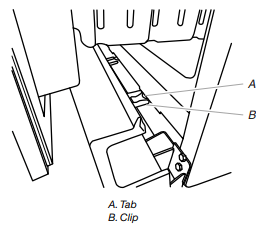
 WARNING:
WARNING:
- Electrical Shock Hazard
- Plug into a grounded 3 prong outlet.
- Do not remove ground prong.
- Do not use an adapter.
- Do not use an extension cord.
- Failure to follow these instructions can result in death, fire, or electrical shock.
- Plug into a grounded 3 prong outlet.
- Return all removable parts to doors and drawer and food to refrigerator and freezer.
Style 1 - Non-Dispenser Models
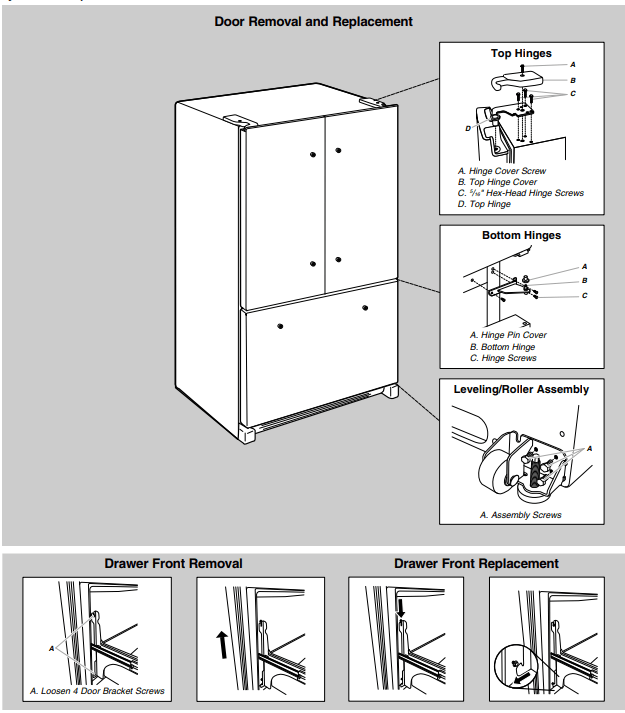
Style 2 - External Water Dispenser Models
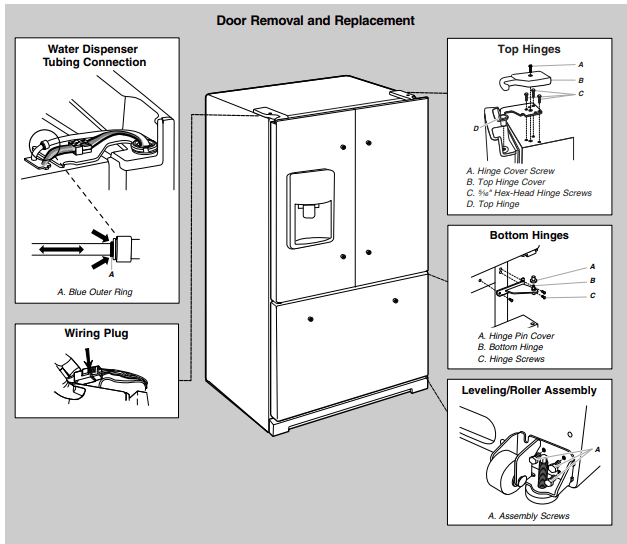
 WARNING:
WARNING:
-
Electrical Requirements
-
Electrical Shock Hazard
-
Plug into a grounded 3 prong outlet.
-
Do not remove ground prong.
-
Do not use an adapter.
-
Do not use an extension cord.
-
Failure to follow these instructions can result in death, fire, or electrical shock.
Before you move your refrigerator into its final location, it is important to make sure you have the proper electrical connection.
Recommended Grounding Method:
A 115 volt, 60 Hz, AC only 15- or 20-amp fused, grounded electrical supply is required. It is recommended that a separate circuit serving only your refrigerator and approved accessories be provided. Use an outlet that cannot be turned off by a switch. Do not use an extension cord.
NOTE: Before performing any type of installation, cleaning, or removing a light bulb, turn OFF Cooling, and then disconnect the refrigerator from the electrical source. When you have finished, reconnect the refrigerator to the electrical source and turn ON Cooling. See “Using the Control(s).”
Water Supply Requirements
A cold water supply with water pressure between 30 and 120 psi (207 and 827 kPa) is required to operate the water dispenser and ice maker. If you have questions about your water pressure, call a licensed, qualified plumber.
Reverse Osmosis Water Supply
IMPORTANT: The pressure of the water supply coming out of a reverse osmosis system going to the water inlet valve of the refrigerator needs to be between 30 and 120 psi (207 and 827 kPa).
If a reverse osmosis water filtration system is connected to your cold water supply, the water pressure to the reverse osmosis system needs to be a minimum of 40 to 60 psi (276 to 414 kPa). If the water pressure to the reverse osmosis system is less than 40 to 60 psi (276 to 414 kPa):
- Check to see whether the sediment filter in the reverse osmosis system is blocked. Replace the filter if necessary.
- Allow the storage tank on the reverse osmosis system to refill after heavy usage. The tank capacity could be too low to keep up with the requirements of the refrigerator.
- If your refrigerator has a water filter, it may further reduce the water pressure when used in conjunction with a reverse osmosis system. Remove the water filter. See “Water Filtration System.”
Connect the Water Supply
Read all directions before you begin.
IMPORTANT:
- All installations must meet local plumbing code requirements.
- Use copper tubing or Whirlpool supply line, Part Number 8212547RP, and check for leaks.
- Install copper tubing only in areas where the temperatures will remain above freezing.
TOOLS NEEDED: Gather the required tools and parts before starting installation. Read and follow the instructions provided with any tools listed here.
- Flat-blade screwdriver
- ⁷⁄₁₆" and ¹⁄₂" Open-end or two adjustable wrenches
- ¹⁄₄" Nut driver
- ¹⁄₄" Drill bit
- Cordless drill
NOTE: Your refrigerator dealer has a kit available with a ¹⁄₄" (6.35 mm) saddle-type shut-off valve, a union, and copper tubing. Before purchasing, make sure a saddle-type valve complies with your local plumbing codes. Do not use a piercing-type or ³⁄₁₆" (4.76 mm) saddle valve which reduces water flow and clogs more easily.
Connect to Water Line
Style 1
- Unplug refrigerator or disconnect power.
- Turn OFF main water supply. Turn ON nearest faucet long enough to clear line of water.
- Locate a ½" to 1¹⁄₄" (1.25 cm to 3.18 cm) vertical cold water pipe near the refrigerator.
IMPORTANT:
■ Make sure it is a cold water pipe.
■ Horizontal pipe will work, but drill on the top side of the pipe, not the bottom. This will help keep water away from the drill and normal sediment from collecting in the valve.
4. Determine the length of copper tubing you need. Measure from the connection on the lower left rear of refrigerator to the water pipe. Add 7 ft (2.1 m) to allow for cleaning. Use ¹⁄₄" (6.35 mm) O.D. (outside diameter) copper tubing. Be sure both ends of copper tubing are cut square.
5. Using a cordless drill, drill a ¹⁄₄" hole in the cold water pipe you have selected.
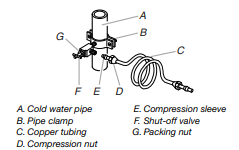
6. Fasten the shut-off valve to the cold water pipe with the pipe clamp. Be sure the outlet end is solidly in the ¹⁄₄" (6.35 mm) drilled hole in the water pipe and that the washer is under the pipe clamp. Tighten the packing nut. Tighten the pipe clamp screws slowly and evenly so washer makes a watertight seal. Do not overtighten or you may crush the copper tubing.
7. Slip the compression sleeve and compression nut onto the copper tubing as shown. Insert the end of the tubing into the outlet end squarely as far as it will go. Screw compression nut onto outlet end with adjustable wrench. Do not overtighten.
8. Place the free end of the tubing in a container or sink, and turn ON the main water supply. Flush the tubing until water is clear. Turn OFF the shut-off valve on the water pipe. Coil the copper tubing.
Style 2
- Unplug refrigerator or disconnect power.
- Remove and discard the black nylon plug from the gray water tube on the rear of the refrigerator.
- Thread the provided nut onto the water valve as shown.
NOTE: Tighten the nut by hand. Then tighten it with a wrench two more turns. Do not overtighten.
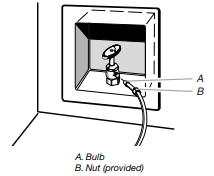
4. Turn shut-off valve ON.
5. Check for leaks. Tighten any nuts or connections (including connections at the valve) that leak.
Connect to Refrigerator
Style 1
1. Unplug refrigerator or disconnect power.
2. Attach the copper tube to the valve inlet using a compression nut and sleeve as shown. Tighten the compression nut. Do not overtighten.
3. Use the tube clamp on the back of the refrigerator to secure the tubing to the refrigerator as shown. This will help avoid damage to the tubing when the refrigerator is pushed back against the wall.
4. Turn shut-off valve ON.
5. Check for leaks. Tighten any connections (including connections at the valve) or nuts that leak.

6. On models with ice makers, the ice maker is equipped with a built-in water strainer. If your water conditions require a second water strainer, install it in the ¹⁄₄" (6.35 mm) water line at either tube connection. Obtain a water strainer from your nearest appliance dealer.
Style 2
- Unplug refrigerator or disconnect power.
- Remove and discard the black nylon plug from the gray water tube on the rear of the refrigerator.
- If the gray water tube supplied with the refrigerator is not long enough, a ¹⁄₄" x ¹⁄₄" (6.35 mm x 6.35 mm) coupling is needed in order to connect the water tubing to an existing household water line. Thread the provided nut onto the coupling on the end of the copper tubing.
NOTE: Tighten the nut by hand. Then tighten it with a wrench two more turns. Do not overtighten.
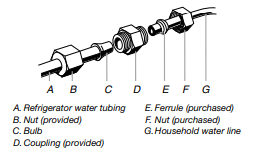
4. Turn shut-off valve ON
5. Check for leaks. Tighten any nuts or connections (including connections at the valve) that leak.
Complete the Installation
 WARNING: Electrical Shock Hazard
WARNING: Electrical Shock Hazard
Do not remove ground prong.
Do not use an adapter.
Do not use an extension cord.
Failure to follow these instructions can result in death, fire, or electrical shock.
1. Plug into a grounded 3 prong outlet.
NOTES:
- Allow 24 hours to produce the first batch of ice. Discard the first three batches of ice produced. Allow 3 days to completely fill ice container.
- For models with a water dispenser, flush the water system. See “Water Dispenser.”
Handle Installation and Removal
Parts Included: Refrigerator door handles (2), Freezer drawer handle (1)
Tools Needed: ¹⁄₈" Hex key wrench
Install Door Handles
NOTE: Handle mounting setscrews are preinstalled inside the handle.
1. Remove the handles from the packaging inside the refrigerator.
2. Open a refrigerator door. On the opposite door, place the handle on the shoulder screws with the setscrews facing the adjacent door.
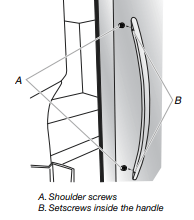
3. Firmly push the handle toward the door until the handle base is flush against the door.
4. While holding the handle, insert the short end of the hex key into the upper hole and slightly rotate the hex key until it is engaged in the setscrew.
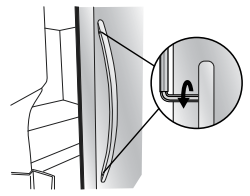
5. Using a clockwise motion tighten the setscrew just until it begins to contact the shoulder screw. Do not fully tighten.
6. Repeat steps 4 and 5 to fasten the lower setscrew.
7. Once both setscrews have been partially tightened as instructed in the previous steps, fully tighten both setscrews. IMPORTANT: When the screws feel tight, tighten them an additional quarter-turn. The handle is not properly installed without this extra tightening.
8. Repeat steps 2 through 6 to install the other handle onto the adjacent refrigerator door.
Install Drawer Handle
1. With the freezer drawer closed, place the handle on the shoulder screws with the setscrews facing down toward the floor.
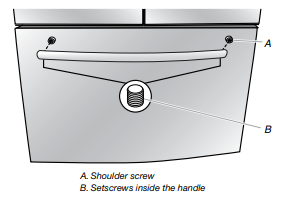
2. Firmly push the handle toward the drawer until the handle base is flush against the drawer.
3. Insert the short end of the hex key into the left-hand hole and slightly rotate the hex key until it is engaged in the setscrew.

4. Using a left-to-right motion tighten the setscrew a quarter-turn at a time. Repeat until the screw feels tight.
5. Repeat steps 3 and 4 to fasten the right-hand setscrew to the shoulder screw.
6. Once both setscrews have been partially tightened as instructed in the previous steps, fully tighten both setscrews. IMPORTANT: When the screws feel tight, tighten them an additional quarter-turn. The handle is not properly installed without this extra tightening.
7. Save the hex key and all instructions.
Remove the Handles
- While holding the handle, insert the short end of the hex key into a setscrew hole and slightly rotate the hex key until it is engaged in the setscrew.
- Using a right-to-left motion loosen the setscrew a quarter-turn at a time.
- Repeat steps 1 and 2 for the other setscrew. Slowly pull the handle away from the door or drawer.
- If necessary, use a Phillips screwdriver to remove the shoulder screws from the door.
Door Closing and Door Alignment
IMPORTANT: To comply with American Disabilities Act (ADA) guidelines, fully retract the rollers into the cabinet to lower the refrigerator.
Door Closing
The base grille covers the leveling screws and roller assemblies located at the bottom of the refrigerator cabinet below the freezer drawer. Before making adjustments, remove the base grille and move the refrigerator to its final location.
1. Remove the base grille. Grasp the grille firmly and pull it toward you.
2. Move the refrigerator to its final location. NOTE: To allow the refrigerator to roll easier, raise the leveling legs off the floor by turning the leveling screws counterclockwise. The front rollers will be touching the floor.
3. So the doors will close easier, use a ¹⁄₄" hex driver to turn both leveling screws clockwise. This will raise the front of the refrigerator tilting it slightly downward to the rear. Turn both leveling screws the same amount. NOTE: Having someone push against the top of the refrigerator takes some weight off the leveling screws. This makes it easier to turn the screws.
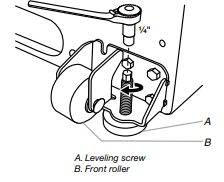
4. Open both doors again to make sure they close as easily as you like and that they stay closed. If not, tilt the refrigerator slightly more to the rear by turning both leveling screws to the right. It may take several more turns. NOTE: To keep the refrigerator level, you should turn both leveling screws the same amount.
5. Replace the base grille.
- Pull open the freezer drawer.
- Align the three clips on the back of the base grille with the three tabs at the base of the refrigerator.
- Push the base grille in toward the refrigerator until it is firmly in place.
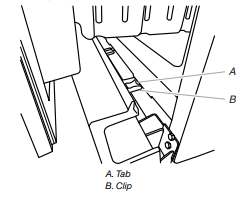
Door Alignment
If the space between the refrigerator doors and freezer drawer looks uneven, you can adjust it using the following instructions:
- Remove the top hinge cover.
- Loosen the top hinge screws using a ⁵⁄₁₆" socket or wrench.
- Have someone hold the door in place or put a spacer between the doors and drawer.
- Tighten the top hinge screws once the door is in the desired location.
- Replace the top hinge cover.
FILTERS AND ACCESSORIES
Water Filtration System
Do not use with water that is microbiologically unsafe or of unknown quality without adequate disinfection before or after the system. Systems certified for cyst reduction may be used on disinfected waters that may contain filterable cysts.
Water Filter Status Light
The water filter status light on the control panel will help you know when to order and replace the water filter.
- GOOD - The water filter icon on the control lights up in BLUE.
- ORDER a replacement filter - The water filter icon on the control lights up in YELLOW.
- REPLACE the water filter - The water filter icon on the control lights up in RED and “Replace Filter” will appear on the display.
- EXPIRED - The water filter icon lights up in RED and “Replace Filter” flashes on the display. NOTE: If water flow to your water dispenser or ice maker decreases noticeably, change the filter sooner. The disposable water filter should be replaced at least every 6 months, depending on your water quality and usage.
- After changing the water filter, reset the status. Press and hold the WATER FILTER button for 3 seconds. When the system is reset, the water filter icon will return to its BLUE color and the words “Replace Filter” will disappear from the display.
Changing the Water Filter

- Locate the water filter in the top-right corner of the refrigerator compartment.
- Lift open the filter cover door. The filter will be released and then eject as the door is opened.
- When the door is completely open, pull the filter straight out.
NOTE: There may be some water in the filter. Some spilling may occur. Use a towel to wipe up any spills.
4. Take the new filter out of its packaging and remove the covers from the O-rings. Be sure the O-rings are still in place after the covers are removed.
5. With the arrow pointing up, align the new filter with the filter housing and slide it into place. The filter cover door will automatically begin to close as the new filter is inserted.
6. Close the filter cover door completely in order to snap the filter into place. You may need to press hard.
7. Flush the water system. See “Water Dispenser” or “Water and Ice Dispensers.”
Install Air Filter (on some models)
The air filter reduces the buildup of odors. This helps to maintain a cleaner environment inside the refrigerator. On some models, your refrigerator's accessory packet includes an air filter, which must be installed prior to use. On some models, the air filter is already installed at the factory.

Installing the Air Filter
Install the air filter behind the vented door, located along the rear interior wall of the refrigerator compartment.
- Remove the air filter from its packaging. NOTE: An air filter status indicator is included with the air filter. The indicator is not needed for models that display the air filter status on the control panel.
- Lift open the vented door.
- Snap the filter into place.
Air Filter Status Indicator
The control panel displays the Air Filter status.
- GOOD - The air filter icon on the control panel lights up in BLUE.
- ORDER a replacement - The air filter icon on the control panel lights up in YELLOW.
- REPLACE air filter - The air filter icon on the control panel lights up in RED and “Replace Filter” will appear.
- EXPIRED - The air filter icon lights up in RED and “Replace Filter” flashes on the control panel.
After replacing the air filter, press and hold the AIR FILTER button for 3 seconds. The filter icons will turn off. See “Using the Control(s).” When the system is reset, the air filter icon will return to its BLUE color and the words “Replace Filter” will disappear from the control panel.
NOTE: At any filter status, pressing and holding the AIR FILTER button for 3 seconds will reset the air filter status to Good and the air filter icon will turn off.
Replacing the Air Filter
The disposable air filter should be replaced every 6 months, or when the status indicator air filter icon turns on and starts flashing when the refrigerator door is opened.
To order a replacement air filter, contact us. See “Accessories.”
1. Remove the used air filter by squeezing in on the side tabs.
2. Install the new air filter and reset the status indicator using the instructions in the previous section.
Install Produce Preserver (on some models)
The accessory packet includes two produce preserver pouches, which should be installed in a crisper drawer prior to use.
NOTE: For best performance, always use two pouches. The produce preserver absorbs ethylene, to slow the ripening process of many produce items. As a result, certain produce items will stay fresh longer.
Ethylene production and sensitivity varies depending on the type of fruit or vegetable. To preserve freshness, it is best to separate produce with sensitivity to ethylene from fruits that produce moderate to high amounts of ethylene.
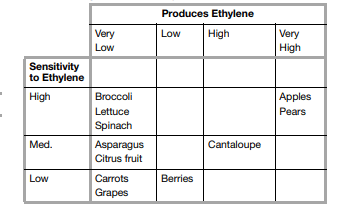
Installing the Produce Preserver
CAUTION: IRRITANT
MAY IRRITATE EYES AND SKIN. DANGEROUS FUMES FORM WHEN MIXED WITH OTHER PRODUCTS. Do not mix with cleaning products containing ammonia, bleach or acids. Do not get in eyes, on skin or clothing. Do not breathe dust. Keep out of reach of children.
FIRST AID TREATMENT: Contains potassium permanganate. If swallowed, call a Poison Control Center or doctor immediately. Do not induce vomiting. If in eyes, rinse with water for 15 minutes. If on skin, rinse with water.
The produce preserver pouches should be installed in the housing, located on the wall of one of the crisper drawers.
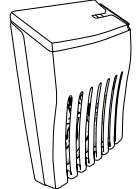
- Remove the FreshFlow™ Produce Preserver pouches from the packaging.
- Lift up on the housing to remove it from the mounting tab.
- Open the housing by pulling up and out on the back of the top of the housing.
- Place both pouches inside the housing, then snap the housing back together.
- Place the housing back on the mounting tab.
Installing the Status Indicator
The produce preserver comes with a status indicator, which should be activated and installed at the same time the pouches are installed.
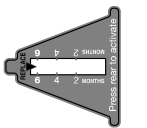
- Place the indicator face-down on a firm, flat surface.
- Apply pressure to the bubble on the back of the indicator until the bubble pops, to activate the indicator.
- Slide open the cap on the top of the produce preserver housing.
- Place the indicator in the top of the housing, facing outward.
- Slide the cap closed, and check that the indicator is visible through the rectangular hole in the cap.
NOTE: The cap will not easily close if the indicator’s bubble has not been popped.
Replacing the Produce Preserver
The disposable pouches should be replaced every 6 months, when the status indicator has completely changed from white to red. To order replacements, contact us. See “Accessories” for information on ordering.
- Remove the used pouches from the produce preserver housing.
- Remove the used status indicator.
- Install the replacement pouches and status indicator using the instructions in the previous sections.
REFRIGERATOR USE
Opening and Closing Doors
There are two refrigerator compartment doors. The doors can be opened and closed either separately or together. There is a vertically-hinged seal on the left refrigerator door.
- When the left-hand refrigerator door is opened, the hinged seal automatically folds inward so that it is out of the way.
- When both doors are closed, the hinged seal automatically forms a seal between the two doors.
Using the Controls
IMPORTANT:
- Wait 24 hours for your refrigerator to cool completely before adding food. If you add food before the refrigerator has cooled completely, your food may spoil. NOTE: Adjusting the refrigerator and freezer temperature controls to a colder than recommended setting will not cool the compartments any faster.
- The recommended setting should be correct for normal household refrigerator use. The controls are set correctly when milk or juice is as cold as you like and when ice cream is firm.
- If the temperature is too warm or too cold in the refrigerator or freezer, first check the air vents to be sure they are not blocked before adjusting the controls.
Control Panel
Depending on your model, your refrigerator has either an internal control panel, located at the top of the refrigerator compartment, or an external control panel, located above the external water dispenser. Follow the instructions specific to your model.
Internal Control Panel
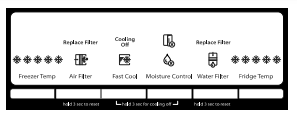
External Control Panel
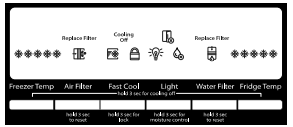
IMPORTANT (External Control only): The display screen on the dispenser control panel will turn off automatically and enter “sleep” mode when the control buttons and dispenser paddles have not been used for 2 minutes or more. While in “sleep” mode, the first press of a control button will only reactivate the display screen, without changing any settings. After reactivation, changes to any settings can then be made. If no changes are made within 2 minutes, the display will re-enter “sleep” mode.
■ Touch any control button on the dispenser panel to activate the display screen.
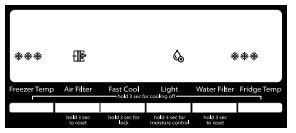
Temperature Control
For your convenience, the temperature control is preset at the factory. When you first install your refrigerator, make sure the control is still set to the recommended setting as shown.
Recommended Setting “3 Snowflakes”
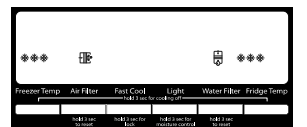
Adjusting the Controls
If you need to adjust the temperature in either the refrigerator or freezer compartment, use the settings listed in the following chart as a guide.
- Press the TEMP button to display the desired number of snowflakes from 1 snowflake (least cold) to all 5 snowflakes (coldest).
NOTE: Except when starting the refrigerator, do not adjust the control more than one setting at a time. Wait 24 hours between adjustments for the temperature to stabilize.

Cooling On/Off
Your refrigerator and freezer will not cool when cooling is turned off. Follow the directions specific to your model.
Internal Control Panel
- To turn cooling off, press and hold both the FAST COOL and MOISTURE CONTROL buttons at the same time for 3 seconds. When cooling is off, “Cooling Off” will appear on the display screen.
- To turn cooling back on, press and hold both the FAST COOL and MOISTURE CONTROL buttons at the same time for 3 seconds. When cooling is ON, “Cooling Off” will disappear and the previously selected settings will appear on the display screen.
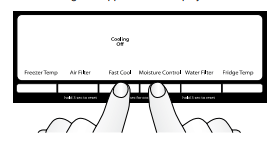
External Control Panel
- To turn cooling off, press and hold both the FREEZER TEMP and FRIDGE TEMP buttons at the same time for 3 seconds. When cooling is OFF, “Cooling Off” will appear on the display screen.
- To turn cooling back on. Press and hold both the FREEZER TEMP and FRIDGE TEMP buttons at the same time for 3 seconds. When cooling is ON, “Cooling Off” will disappear and the previously selected settings will appear on the display screen.
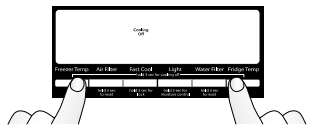
Additional Features
Door Open Alarm
- The Door Open icon lights up whenever either door is opened.

- When either door is open for 5 minutes and cooling is on, an alert tone will sound three times, and the Door Open icon will flash seven times. This pattern will repeat every 2 minutes until all the doors are closed properly. The feature then resets and will reactivate when either door is left open again for 5 minutes.
NOTES:
- To mute the audible alarm while keeping the doors open, such as while cleaning the inside of the refrigerator, press any button on the control panel. The alarm sound will be temporarily turned off, but the Door Open icon will still be displayed on the dispenser control panel.
- Both doors must be fully closed to turn off the Door Open icon.
Fast Cool
The Fast Cool feature assists during times of high refrigerator use, full grocery loads or temporarily warm room temperatures.
- Press FAST COOL to set the freezer and refrigerator to the coldest temperature settings. Press FAST COOL again to return to the selected temperature set point.
NOTES:
- The Fast Cool icon will be illuminated while the refrigerator is in Fast Cool mode.
- The Fast Cool feature will turn off automatically after 24 hours.

Moisture Control
The moisture control feature turns on a heater to help reduce moisture on the door hinge seal. Use in humid environments or when you notice moisture on the door hinge seal. The refrigerator uses more energy when Moisture Control is ON.
NOTE: The moisture control icon will light up to indicate the feature is ON.
To turn on/off the moisture control feature:
- Internal Control Panel - Press and hold MOISTURE CONTROL for 3 seconds.
- External Control Panel - Press and hold LIGHT for 3 seconds.

Water Filter Status Light and Reset
The filter reset control allows you to restart the water filter status tracking feature each time you replace the water filter. See “Water Filtration System.”
- Press and hold WATER FILTER for 3 seconds, to reset the water filter status to Good. The water filter icon will turn blue.

Air Filter Status Light and Reset
The filter reset control allows you to restart the air filter status tracking feature each time you replace the air filter. See “Install Air Filter.”
- Press and hold AIR FILTER for 3 seconds, to reset the air filter status to Good. The air filter icon will turn blue.
Water Dispenser (on some models)
IMPORTANT:
■ Allow 3 hours for the refrigerator to cool down and chill water.
■ Allow 24 hours to produce the first batch of ice. Discard the first three batches of ice produced.
■ The dispensing system will not operate when the refrigerator door is open.
Flush the Water System
Air in the water dispensing system can cause the water dispenser to drip. After connecting the refrigerator to a water source or replacing the water filter, flush the water system.
Flushing the water dispensing system forces air from the water line and filter and prepares the water filter for use. Additional flushing may be required in some households.
NOTE: As air is cleared from the system, water may spurt out of the dispenser.
- Using a sturdy container, depress and hold the water dispenser paddle for 5 seconds.
- Release the dispenser paddle for 5 seconds.
- Repeat steps 1 and 2 until water begins to flow.
- Once water begins to flow, continue depressing and releasing the dispenser paddle (5 seconds on, 5 seconds off) until a total of 4 gal. (15 L) has been dispensed.
Dispense Water
IMPORTANT:
■ The dispensing system will not operate when the refrigerator door is open.
■ The display screen on the dispenser control panel will turn off automatically and enter “sleep” mode when the control buttons and dispenser paddles have not been used for 2 minutes or more. While in “sleep” mode, the first press of a control button will only reactivate the display screen, without changing any settings. After reactivation, changes to any settings can then be made. If no changes are made within 2 minutes, the display will re-enter “sleep” mode.
To dispense water:
1. Press a sturdy glass against the water dispenser paddle.
2. Remove the glass to stop dispensing.
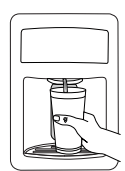
Dispenser Light
When you use the dispenser, the light will automatically turn on. If you want the light to be on continuously, you may turn on the light. The light icon will illuminate when the light is ON.

ON: Press LIGHT quickly to turn on the dispenser light.
OFF: Press LIGHT quickly to turn off the dispenser light.
NOTES:
■ If you unintentionally press and hold the LIGHT button for 3 seconds or longer, you will turn on the Moisture Control feature. If this happens, press and hold LIGHT for 3 seconds again to turn off the Moisture Control feature.
■ The dispenser lights are LEDs that cannot be changed. If it appears that your dispenser lights are not working, see “Troubleshooting” for more information.
Dispenser Lock
The dispenser can be turned off for easy cleaning or to avoid unintentional dispensing by small children and pets.
NOTE: The lock feature does not shut off power to the refrigerator, to the ice maker, or to the dispenser light. It simply deactivates the controls and dispenser paddles. To turn off the ice maker, see “Ice Maker and Storage Bin.”
■ Press and hold FAST COOL for 3 seconds to lock the dispenser.
■ Press and hold FAST COOL for 3 seconds again to unlock the dispenser.
The lock icon will illuminate when the dispenser is locked.

Ice Maker
IMPORTANT: For models with a water filter, after connecting the refrigerator to a water source or replacing the water filter, fill and discard three full containers of ice to prepare the water filter for use.
Turning the Ice Maker On/Off
To turn ON the ice maker, simply lower the wire shut-off arm. To manually turn OFF the ice maker, lift the wire shut-off arm to the OFF (arm up) position and listen for the click.
NOTE: Your ice maker has an automatic shutoff. As ice is made, the ice cubes will fill the ice storage bin and the ice cubes will raise the wire shut-off arm to the OFF (arm up) position. Do not force the wire shut-off arm up or down.
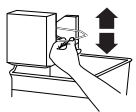
Ice Storage Bin
- Wash the ice storage bin with mild soap and warm water.
- Slide the ice storage bin under the ice maker, and push it toward the back as far as it will go.
- Lower the arm on the ice maker to the ON position.
NOTE: It usually takes approximately 24 hours for the ice maker to begin producing ice. You may notice the ice has an “off-taste.” If so, discard the first three batches of ice produced. After that the “off-taste” should be gone.
Ice Production Rate
- The ice maker should produce approximately 8 to 12 batches of ice in a 24-hour period. Allow 3 days to completely fill the ice container.
- To increase ice production, lower the freezer and refrigerator temperature. See “Using the Control(s).” Wait 24 hours between adjustments.
Remember
■ The quality of your ice will be only as good as the quality of the water supplied to your ice maker. Avoid connecting the ice maker to a softened water supply. Water softener chemicals (such as salt) can damage parts of the ice maker and lead to poor quality ice. If a softened water supply cannot be avoided, make sure the water softener is operating properly and is well maintained.
■ Do not use anything sharp to break up the ice in the bin. This can cause damage to the ice storage bin and the dispenser mechanism.
■ Do not store anything on top of or in the ice maker or ice storage bin.
REFRIGERATOR FEATURES
NOTE: Your model may have some or all of these features.
Important information to know about glass shelves and covers:
Do not clean glass shelves or covers with warm water when they are cold. Shelves and covers may break if exposed to sudden temperature changes or impact, such as bumping. Tempered glass is designed to shatter into many small, pebble-size pieces. This is normal. Glass shelves and covers are heavy. Use both hands when removing them to avoid dropping.
Refrigerator Shelves
The shelves in your refrigerator are adjustable to match your individual storage needs.
Glass Shelves
To remove a shelf:
- Remove items from the shelf.
- Slide the shelf straight out to the stop.
- Depending on your model, lift the back or front of the shelf past the stop. Pull the shelf out the rest of the way.
To replace a shelf:
- Slide the back of the shelf into the track in the wall of the cabinet.
- Guide the front of the shelf into the shelf track. Be sure to slide the shelf in all the way.

Foldaway Shelf (on some models)
To retract the foldaway shelf:
- Retract the foldaway section of the shelf by holding the front of the shelf with one hand and lifting up on the center front of the shelf. Then push back and down on the shelf until it slides beneath the back section of the shelf.
To replace the foldaway shelf:
■ Replace the foldaway section of the shelf by holding the front of the shelf with one hand and pulling the center of the shelf until the foldaway section is returned to its full shelf position.
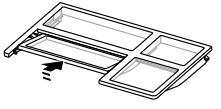
Pantry Drawer
Pantry Drawer
To remove and replace the pantry drawer:
- Slide pantry drawer out to the stop.
- Lift front of pantry drawer with one hand while supporting bottom of drawer with other hand. Slide drawer out the rest of the way.
- Replace the drawer by sliding it back in fully past the drawer stop.
Pantry Drawer Cover
To remove and replace the pantry drawer cover:
- Remove the pantry drawer.
- From underneath, push up on the glass cover and pull it out.
- Replace the pantry drawer cover by lowering it into place.
- Replace the pantry drawer.
Pantry Drawer Control
The amount of air flowing through the pantry drawer affects the temperature inside the drawer. The airflow control is located on the left side of the pantry drawer.
To adjust the airflow:
- Colder - Slide the control forward, toward the front of the pantry drawer. The airflow is open.
- Cold - Slide the control all the way toward the rear of the pantry drawer. The airflow is closed, as shown.
Crisper
Crisper Drawers
To remove and replace the crisper drawer:
- Slide the crisper drawer straight out to the stop. Lift the front and slide the drawer out the rest of the way.
- Replace the drawer by sliding the drawer in fully past the stop.
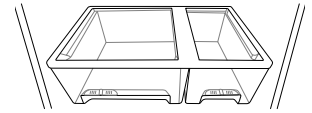
Crisper Cover
To remove and replace the glass crisper cover:
- Pull the glass straight out.
- Replace the glass by pushing it straight in.
Crisper Humidity Control (on some models)
You can control the amount of humidity in the moisture-sealed crisper. Adjust the control to any setting between LOW and HIGH. LOW (open) lets moist air out of the crisper for best storage of fruits and vegetables with skins.
- Fruit: Wash, let dry and store in refrigerator in plastic bag or crisper. Do not wash or hull berries until they are ready to use. Sort and keep berries in original container in crisper, or store in a loosely closed paper bag on a refrigerator shelf.
- Vegetables with skins: Place in plastic bag or plastic container and store in crisper. HIGH (closed) keeps moist air in the crisper for best storage of fresh, leafy vegetables.
- Leafy vegetables: Wash in cold water, drain and trim or tear off bruised and discolored areas. Place in plastic bag or plastic container and store in crispe
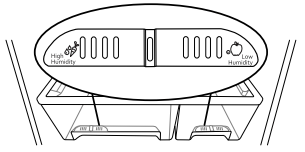
DOOR FEATURES
NOTE: Your model may have some or all of these features.
Condiment Bins
To remove and replace the condiment bins:
1. Tilt the bin by pulling it outward.
2. Remove the bin by lifting it upward off the glides.
3. Replace the bin by sliding it back onto the glides and then push it closed.

Fresh Bin (on some models)
To remove and replace the fresh bin:
- Open the bin by grasping the top center lip of the bin and tilting the bin outward.
- Remove the bin by grasping both sides of the bin and lifting the bin upward off the glides.
- Replace the bin by sliding it back into its tilted position on the glides and then push it closed.
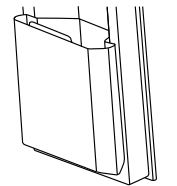
Half-Height Bin (on some models)
To remove and replace the half-height bin:
- Tilt the bin by pulling it outward.
- Remove the bin by lifting it upward off the glides.
- Replace the bin by sliding it back onto the glides and then push it closed.
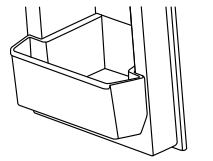
TROUBLESHOOTING
Operation
 WARNING Electrical Shock Hazard
WARNING Electrical Shock Hazard
Plug into a grounded 3 prong outlet.
Do not remove ground prong.
Do not use an adapter.
Do not use an extension cord.
Failure to follow these instructions can result in death, fire, or electrical shock.
The refrigerator will not operate
Check electrical supply
- Plug the power cord into a grounded 3 prong outlet.
- Do not use an extension cord.
- Make sure there is power to the outlet. Plug in a lamp to see if the outlet is working.
- Reset a tripped circuit breaker. Replace any blown fuses. NOTE: If problems continue, contact an electrician.
Check controls
- Make sure the controls are turned on. See “Using the Controls.”
New installation
- Allow 24 hours following installation for the refrigerator to cool completely. NOTE: Adjusting the temperature controls to the coldest setting will not cool either compartment quicker.
The motor seems to run too much
High-efficiency compressor and fans
- This is normal. Larger, more efficient refrigerators run longer.
The room or outdoor temperature is hot
- It is normal for the refrigerator to work longer under these conditions. For optimum performance, place the refrigerator in an indoor, temperature-controlled environment. See “Location Requirements.”
A large amount of warm food has been recently added
- Warm food will cause the refrigerator to run longer until the air cools to the desired temperature.
The door(s) are opened too frequently or for too long
- Warm air entering the refrigerator causes it to run more. Open the door less often.
The refrigerator door or freezer drawer is ajar
- Make sure the refrigerator is level. See “Door Closing and Door Alignment.” Keep food and containers from blocking the door.
The refrigerator control is set too cold
- Adjust the refrigerator control to a less cold setting until the refrigerator temperature is as desired. See “Using the Controls.”
The door or drawer gasket is dirty, worn, or cracked
- Clean or change the gasket. Leaks in the door seal will cause the refrigerator to run longer in order to maintain desired temperatures.
The lights do not work
A light bulb is loose in the socket or burned out
- Tighten or replace the light bulb. See “Changing the Light Bulbs.”
The dispenser light is set to OFF
- On some models, the dispenser light will operate only when a dispenser paddle is pressed. If you want the dispenser light to stay on continuously, see “Water Dispenser.”
The control is set to Sabbath mode (on some models)
- Turn off Sabbath mode. See “Using the Controls.”
Noise
The refrigerator seems noisy
Below are listed some normal sounds with explanations.
The compressor in your new refrigerator regulates temperature more efficiently while using less energy, and operates quietly. Due to the reduction in operating noise, you may notice more intermittent noises.
Sound of the compressor running longer than expected
High efficiency compressor and fans
- This is normal. Larger, more efficient refrigerators run longer.
Pulsating/Whirring
Fans/compressor adjusting to optimize performance during normal compressor operation
- This is normal.
Popping
Contraction/expansion of inside walls, especially during initial cool-down
- This is normal.
Hissing/Dripping
Flow of refrigerant, or flow of oil in the compressor
- This is normal.
Vibration
The refrigerator may not be steady
- Adjust the leveling screws and lower the leveling foot firmly against the floor. See “Door Closing and Door Alignment.”
Rattling/Banging
Movement of the water lines against the refrigerator cabinet, or of items placed on top of the refrigerator cabinet
- Move excess water line away from the refrigerator cabinet or fasten excess tubing to the cabinet. See “Connect the Water Supply,” or remove items from the top of the refrigerator.
Sizzling
Water dripping on the heater during defrost cycle
- This is normal.
Water running/Gurgling
May be heard when ice melts during the defrost cycle and water runs into the drain pan
- This is normal.
Buzzing
Heard when the water valve opens to fill the ice maker
- This is normal.
Creaking/Cracking
May be heard as ice is being ejected from the ice maker mold
- This is normal.
Ker-plunk
May be heard when the ice falls into the ice storage bin
- This is normal.
Temperature and Moisture
Temperature is too warm
The refrigerator has just been installed
- Allow 24 hours following installation for the refrigerator to cool completely.
Cooling is turned off
- Turn on cooling. See “Using the Controls.”
The controls are not set correctly for the surrounding conditions
- Adjust the controls a setting colder. Check the temperature in 24 hours. See “Using the Control(s).”
The door(s) are opened often or not closed completely
- Allows warm air to enter refrigerator. Minimize door openings and keep doors fully closed.
A large load of food was recently added
- Allow several hours for refrigerator to return to normal temperature.
Temperature is too cold in the refrigerator/crisper
The refrigerator air vent(s) are blocked
- If the air vent located in the top, left, rear corner of the refrigerator compartment is blocked by items placed directly in front of it, the refrigerator will get too cold. Move items away from the air vent.
The controls are not set correctly for the surrounding conditions
- Adjust the controls a setting warmer. Check the temperature in 24 hours. See “Using the Controls.”
The ice storage bin is not in the correct position
- See “Ice Maker.”
Temperature is too cold in the pantry drawers
The control is not set correctly for the items stored in drawer
- Adjust the control setting. See “Refrigerator Features.”
There is interior moisture buildup
NOTE: Some moisture buildup is normal.
The room is humid
- A humid environment contributes to moisture buildup.
The door(s) are opened often or not closed completely
- Allows humid air to enter the refrigerator. Minimize door openings and close doors completely.
The door is blocked open
- Move food packages away from door.
A bin or shelf is in the way
- Push bin or shelf back into the correct position.
Storing liquid in open containers
- This adds humidity to the refrigerator interior. Keep all containers tightly covered.
There is frost/ice buildup in the freezer compartment
The doors are opened often or left open
- Minimize door openings and keep doors fully closed.
Poor door seal
- Ensure door seals are making full contact with the refrigerator cabinet to allow for an adequate seal.
Temperature controls are not set correctly
See “Using the Controls” for recommended temperature settings.
Ice and Water
The ice maker is not producing ice or is not producing enough ice
The refrigerator is not connected to a water supply or the water supply shutoff valve is not turned on
- Connect refrigerator to water supply and turn water shutoff valve fully open.
There is a kink in the water source line
- A kink in the line can reduce water flow. Straighten the water source line.
The ice maker is not turned on
- Make sure the ice maker is ON. See “Ice Maker.”
The refrigerator has just been installed
- Wait 24 hours after ice maker installation for ice production to begin. Wait 3 days for full ice production.
The refrigerator door is not closed completely
- Close the door firmly. If it does not close completely, see “The doors will not close completely.”
A large amount of ice was recently removed
- Allow 24 hours for ice maker to produce more ice.
An ice cube is jammed in the ice maker ejector arm
- Remove ice from the ejector arm with a plastic utensil. NOTE: On some models, press the lever which opens the ice maker door to access the ejector arm.
A water filter is installed on the refrigerator
- Remove the water filter and operate the ice maker. If ice volume improves, then the filter may be clogged or incorrectly installed. Replace filter or reinstall it correctly.
A reverse osmosis water filtration system is connected to your cold water supply
- This can decrease water pressure. See “Water Supply Requirements.”
The ice cubes are hollow or small
NOTE: This is an indication of low water pressure.
The water shut-off valve is not fully open
- Turn the water shut-off valve fully open.
There is a kink in the water source line
- A kink in the line can reduce water flow. Straighten the water source line.
A water filter is installed on the refrigerator
- Remove filter and operate ice maker. If ice quality improves, then the filter may be clogged or incorrectly installed. Replace filter or reinstall it correctly.
A reverse osmosis water filtration system is connected to your cold water supply
- This can decrease water pressure. See “Water Supply Requirements.”
Questions remain regarding water pressure
- Call a licensed, qualified plumber.
Off-taste, odor or gray color in the ice or water
Recently installed or replaced plumbing connections. (New plumbing connections can cause discolored or off-flavored ice and water.)
- Discard the ice and wash the ice storage bin. Flush the water system with 4 gal. (15 L) of water. Allow 24 hours for the ice maker to make new ice, and discard the first 3 batches of ice produced.
The ice has been stored too long
- Discard ice. Wash ice storage bin. Allow 24 hours for ice maker to make new ice.
The water has been stored too long
- Dispense at least 1 qt (1 L) of water per week to maintain a fresh supply.
Odor from stored food has transferred to the ice
- Use airtight, moisture proof packaging to store food.
There are minerals (such as sulfur) in the water
- A water filter may need to be installed to remove the minerals.
There is a water filter installed on the refrigerator
- Gray or dark discoloration in ice may indicate that the water filtration system needs additional flushing. Flush the water system after installing and before using a new water filter. See “Water Dispenser” for water filter flushing instructions.
The water filter needs to be replaced
- Replace the disposable water filter at least every 6 months or when indicated. See “Water Filtration System.”
The water dispenser will not operate properly
The refrigerator is not connected to a water supply or the water supply shut-off valve is not turned on
- Connect the refrigerator to the water supply and turn the water shut-off valve fully open.
There is a kink in the water source line
- A kink in the water line can reduce water flow from the water dispenser and result in hollow or irregular shaped ice. Straighten the water source line.
The refrigerator has just been installed
- Flush and fill the water system. See “Water Dispenser.”
The water pressure to the house is not at or above 30 psi (207 kPa)
- The water pressure to the house determines the flow from the dispenser. See “Water Supply Requirements.”
A reverse osmosis water filtration system is connected to your cold water supply
- A reverse osmosis water filtration system can decrease water pressure. See “Water Supply Requirements.”
A water filter is installed on the refrigerator
- Remove filter and operate dispenser. If water flow increases, the water filter may be clogged or incorrectly installed. Replace filter or reinstall it correctly.
The refrigerator door is not closed completely (on some models)
- Close the door firmly. If it does not close completely, see “The doors will not close completely.”
The refrigerator doors were recently removed
- Make sure the water dispenser wire/tube assembly has been properly reconnected at the top of the refrigerator door. See “Remove and Replace Refrigerator Doors and Drawer Front.”
Water is leaking or dripping from the dispenser system
NOTE: A few drops of water after dispensing is normal.
The glass was not held under the dispenser long enough
- Hold the glass under the dispenser 2 to 3 seconds after releasing the dispenser lever.
Water continues to drip from the dispenser beyond the first few drops.
The refrigerator has just been installed
- Flushing the water system removes the air from the lines which causes the water dispenser to drip. Flush the water system. See “Water Dispenser.”
The water filter was recently changed
- Flushing the water system removes the air from the lines which causes the water dispenser to drip. Flush the water system. See “Water Dispenser.”
Water is leaking from the back of the refrigerator
The water line connections were not fully tightened
- See “Connect the Water Supply.”
Recently removed the doors and did not fully tighten water line connection
- See “Remove and Replace Refrigerator Doors and Drawer Front.”
Water from the dispenser is warm
NOTE: Water from the dispenser is only chilled to 50°F (10°C).
The refrigerator has just been installed
- Allow 24 hours after installation for the water supply to cool completely.
A large amount of water was recently dispensed
- Allow 3 hours for the water supply to cool completely.
Water has not been recently dispensed
- The first glass of water may not be cool. Discard the first glass of water dispensed.
The refrigerator is not connected to a cold water pipe
- Make sure the refrigerator is connected to a cold water pipe. See “Water Supply Requirements.”
Doors
 WARNING Explosion Hazard
WARNING Explosion Hazard
Use nonflammable cleaner.
Failure to do so can result in death, explosion, or fire.
The door(s) or drawer will not close completely
The door or drawer is blocked open
- Move food packages away from door(s). Remove ice or other items which have fallen onto the floor of the freezer compartment.
A bin or shelf is in the way
- Push bin or shelf back into the correct position.
Recently installed
- Remove all packaging materials.
The doors are difficult to open
The door gaskets are dirty or sticky
- Clean gaskets and contact surfaces with mild soap and warm water. Rinse and dry with soft cloth.
The doors appear to be uneven
The doors need to be aligned or the refrigerator needs to be leveled
- See “Door Closing and Door Alignment.”
The doors do not open or close as expected
The refrigerator tilt needs to be adjusted
- Adjust the refrigerator tilt. See “Door Closing and Door Alignment.
See other models: WHAD601AW WRS973CIDM WRS322FNAH WRS331SDHM WRSA71CIHN


